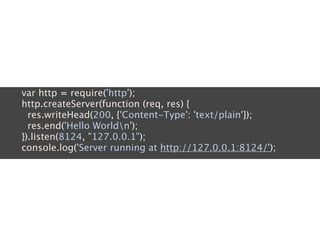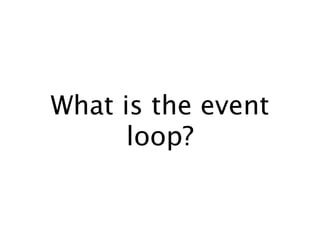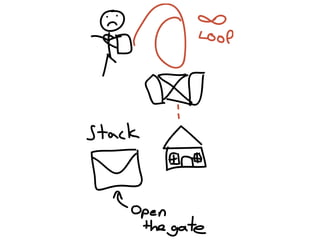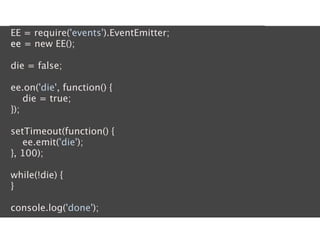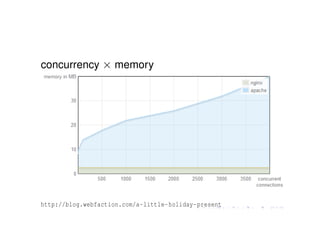A language for the Internet: Why JavaScript and Node.js is right for Internet Applications
- 1. A language for the Internet Why JavaScript and Node.js is right for Internet Applications Tom Hughes-Croucher @sh1mmer
- 5. Scalable Server-Side Code with JavaScript Node Up and Running Tom Hughes-Croucher
- 6. A brief aside. A small lecture on biology
- 7. The common tree shrew
- 8. Diana Monkey
- 11. Back to your feature presentation.
- 12. Internet?
- 21. More features More users More devices More data
- 22. Cost Stuff
- 23. How do we cope with the increase in demand?
- 26. Browser Server Spidering... The Web
- 28. Browser Front-end Server Computation Database
- 29. Computational Computing Client → Server Computation
- 30. Internet Computing Client → Server Server → DB Computation Computation
- 33. Server
- 34. Request
- 37. U L L F
- 39. Place- holder
- 43. Node.js? • Server Side JavaScript runtime • Built on top of V8 JavaScript engine from Google Chrome • Non-blocking I/O APIs • Easy to extend APIs and modules
- 44. $Enki:~ $ node
- 45. $Enki:~ $ node >3>2>1 false > true == 1 true > true === 1 false
- 46. > console.log('Hello World'); Hello World > .help .clear Break, and also clear the local context. .exit Exit the prompt .help Show repl options > .clear Clearing context... > .exit Enki:~ $
- 47. Enki:~ $ node > var foo = "bar"; > foo; 'bar' > .clear Clearing context... > foo ReferenceError: foo is not defined at [object Context]:1:1 at Interface.<anonymous> (repl:98:19) at Interface.emit (events:27:15) at Interface._ttyWrite (readline:295:12) at Interface.write (readline:132:30) at Stream.<anonymous> (repl:79:9) at Stream.emit (events:27:15) at IOWatcher.callback (net:489:16)
- 48. var http = require('http'); http.createServer(function (req, res) { res.writeHead(200, {'Content-Type': 'text/plain'}); res.end('Hello Worldn'); }).listen(8124, "127.0.0.1"); console.log('Server running at http://127.0.0.1:8124/');
- 49. var http = require('http'); //include the http library
- 50. http.createServer(function (req, res) { }).listen(8124, "127.0.0.1"); //create an http server //when ‘stuff’ happens call this anonymous function //listen on port 8124 of the IP 127.0.0.1
- 51. http.createServer(function (req, res) { res.writeHead(200, {'Content-Type': 'text/plain'}); res.end('Hello Worldn'); }) //when ‘stuff’ happens my function fires //I get a request object and a response object //I write to the response object header //HTTP status 200 and content-type ‘text/plain’ //close the response with the body: //Hello World
- 52. console.log('Server running at http://127.0.0.1:8124/'); //write Server is running at http://127.0.0.1:8124/ //to the console
- 53. Why is Node.js suited to Internet Apps?
- 55. What is the event loop?
- 57. Multi-tasking, one thing at a time.
- 60. var http = require('http'); server = http.createServer(); server.on('request', function (req, res) { res.writeHead(200, {'Content-Type': 'text/plain'}); res.end('Hello Worldn'); }); server.listen(8124, "127.0.0.1"); console.log('Server running at http://127.0.0.1:8124/');
- 61. var http = require('http'); server = http.createServer(); server.on('request', function (req, res) { res.writeHead(200, {'Content-Type': 'text/plain'}); res.end('Hello Worldn'); }); server.listen(8124, "127.0.0.1"); console.log('Server running at http://127.0.0.1:8124/'); Step 1. Evaluate 'Main'
- 62. var http = require('http'); server = http.createServer(); server.on('request', function (req, res) { res.writeHead(200, {'Content-Type': 'text/plain'}); res.end('Hello Worldn'); }); server.listen(8124, "127.0.0.1"); console.log('Server running at http://127.0.0.1:8124/'); Step 1. variables: http -> http module server -> http server listeners: server.request -> function
- 63. var http = require('http'); server = http.createServer(); * server.on('request', function (req, res) { res.writeHead(200, {'Content-Type': 'text/plain'}); res.end('Hello Worldn'); }); server.listen(8124, "127.0.0.1"); console.log('Server running at http://127.0.0.1:8124/'); Step 2. Event Loop
- 64. var http = require('http'); server = http.createServer(); * server.on('request', function (req, res) { res.writeHead(200, {'Content-Type': 'text/plain'}); res.end('Hello Worldn'); }); server.listen(8124, "127.0.0.1"); console.log('Server running at http://127.0.0.1:8124/'); Step 2. Do we have active listeners? listeners: server.request -> function Yes! Wait for listeners.
- 65. var http = require('http'); server = http.createServer(); server.on('request', function (req, res) { res.writeHead(200, {'Content-Type': 'text/plain'}); res.end('Hello Worldn'); }); server.listen(8124, "127.0.0.1"); console.log('Server running at http://127.0.0.1:8124/'); Step 3. Event Calls
- 66. var http = require('http'); server = http.createServer(); server.on('request', function (req, res) { res.writeHead(200, {'Content-Type': 'text/plain'}); res.end('Hello Worldn'); }); server.listen(8124, "127.0.0.1"); console.log('Server running at http://127.0.0.1:8124/'); Step 3. 'request' is called. Since listeners: server.request -> function Call function
- 67. var http = require('http'); server = http.createServer(); server.on('request', function (req, res) { res.writeHead(200, {'Content-Type': 'text/plain'}); res.end('Hello Worldn'); }); server.listen(8124, "127.0.0.1"); console.log('Server running at http://127.0.0.1:8124/'); Step 3. Loop! (go to Step 2.)
- 68. Breaking the event loop
- 70. EE = require('events').EventEmitter; ee = new EE(); die = false; ee.on('die', function() { die = true; }); setTimeout(function() { ee.emit('die'); }, 100); while(!die) { } console.log('done');
- 71. Why non-blocking matters
- 72. var result = db.query("select * from T"); // use result
- 73. What are we waiting for?
- 75. "Blocking" is as bad as stopping
- 76. Event Loop vs. Threads
- 77. PHP 8mb 8gb ram 8000/8 = 1000 ~1000 users per machine
- 78. Node.js TCP = 2kb HTTP = 6kb 8gb ram 8000/0.006 = 1.3m 1.3m/2 ~ 650k users
- 79. Apache vs NGINX concurrency × reqs/sec http://blog.webfaction.com/a-little-holiday-present
- 80. Apache vs NGINX concurrency × memory http://blog.webfaction.com/a-little-holiday-present
- 81. Node.js is designed for communication, just like your applications
- 82. Thanks!
- 83. Follow me @sh1mmer Tom Hughes-Croucher @sh1mmer
Editor's Notes
- #2: \n
- #3: \n
- #4: \n
- #5: \n
- #6: \n
- #7: \n
- #8: \n
- #9: \n
- #10: \n
- #11: \n
- #12: \n
- #13: \n
- #14: \n
- #15: \n
- #16: \n
- #17: \n
- #18: \n
- #19: \n
- #20: \n
- #21: \n
- #22: \n
- #23: \n
- #24: \n
- #25: \n
- #26: \n
- #27: \n
- #28: \n
- #29: \n
- #30: \n
- #31: \n
- #32: \n
- #33: \n
- #34: \n
- #35: \n
- #36: \n
- #37: \n
- #38: \n
- #39: \n
- #40: \n
- #41: \n
- #42: \n
- #43: \n
- #44: \n
- #45: \n
- #46: \n
- #47: \n
- #48: \n
- #49: \n
- #50: \n
- #51: \n
- #52: \n
- #53: \n
- #54: \n
- #55: \n
- #56: \n
- #57: \n
- #58: \n
- #59: \n
- #60: \n
- #61: \n
- #62: \n
- #63: \n
- #64: \n
- #65: \n
- #66: \n
- #67: \n
- #68: \n
- #69: \n
- #70: \n
- #71: \n
- #72: \n
- #73: \n
- #74: \n
- #75: \n
- #76: \n
- #77: \n
- #78: \n
- #79: \n
- #80: \n
- #81: \n
- #82: \n
- #83: \n
- #84: \n




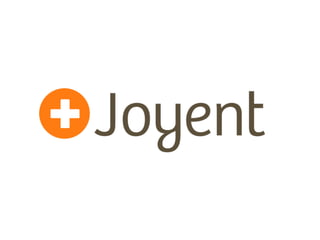










































![Enki:~ $ node
> var foo = "bar";
> foo;
'bar'
> .clear
Clearing context...
> foo
ReferenceError: foo is not defined
at [object Context]:1:1
at Interface.<anonymous> (repl:98:19)
at Interface.emit (events:27:15)
at Interface._ttyWrite (readline:295:12)
at Interface.write (readline:132:30)
at Stream.<anonymous> (repl:79:9)
at Stream.emit (events:27:15)
at IOWatcher.callback (net:489:16)](https://image.slidesharecdn.com/web2-sf-11-110329123847-phpapp02/85/A-language-for-the-Internet-Why-JavaScript-and-Node-js-is-right-for-Internet-Applications-47-320.jpg)
